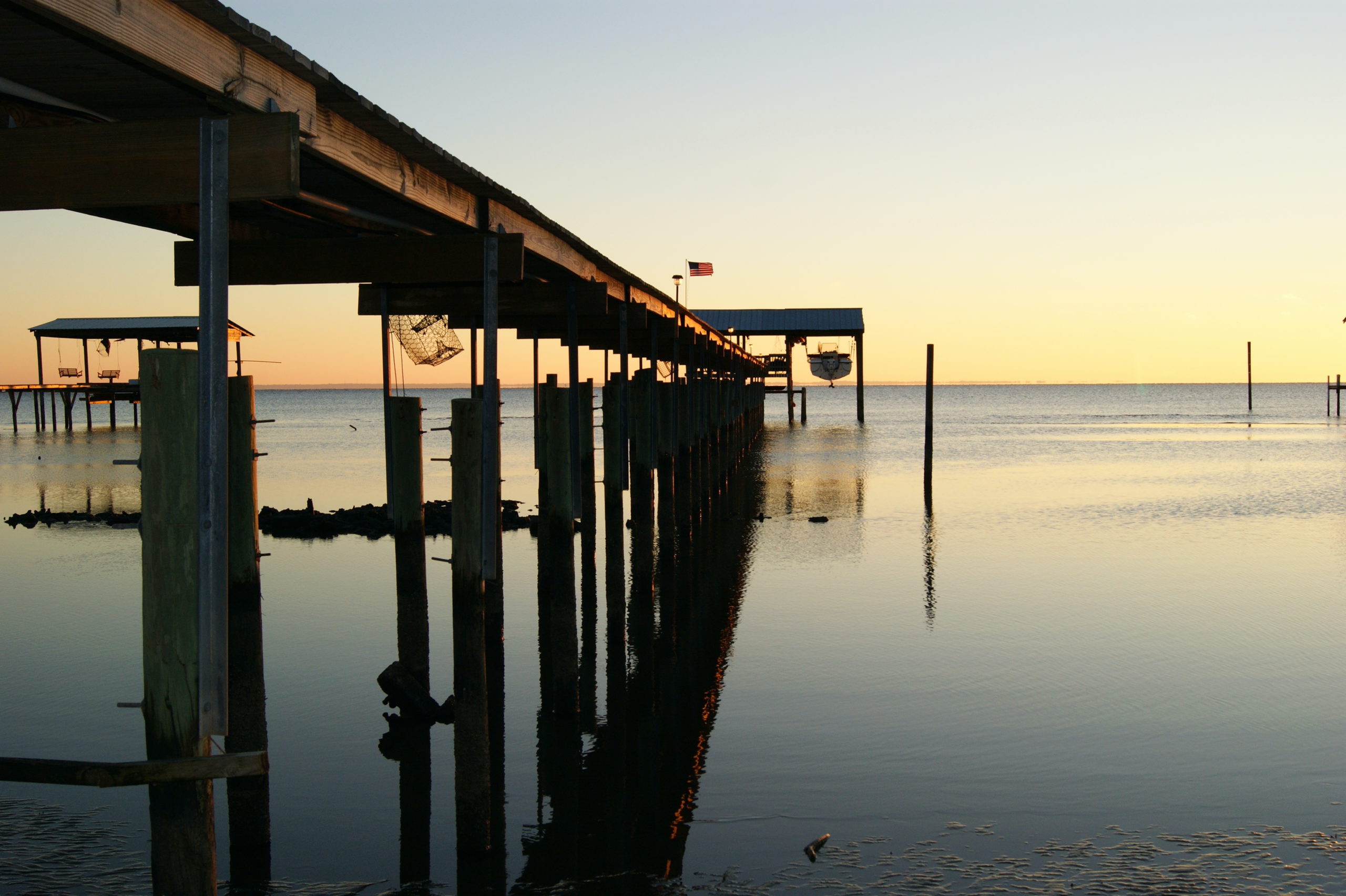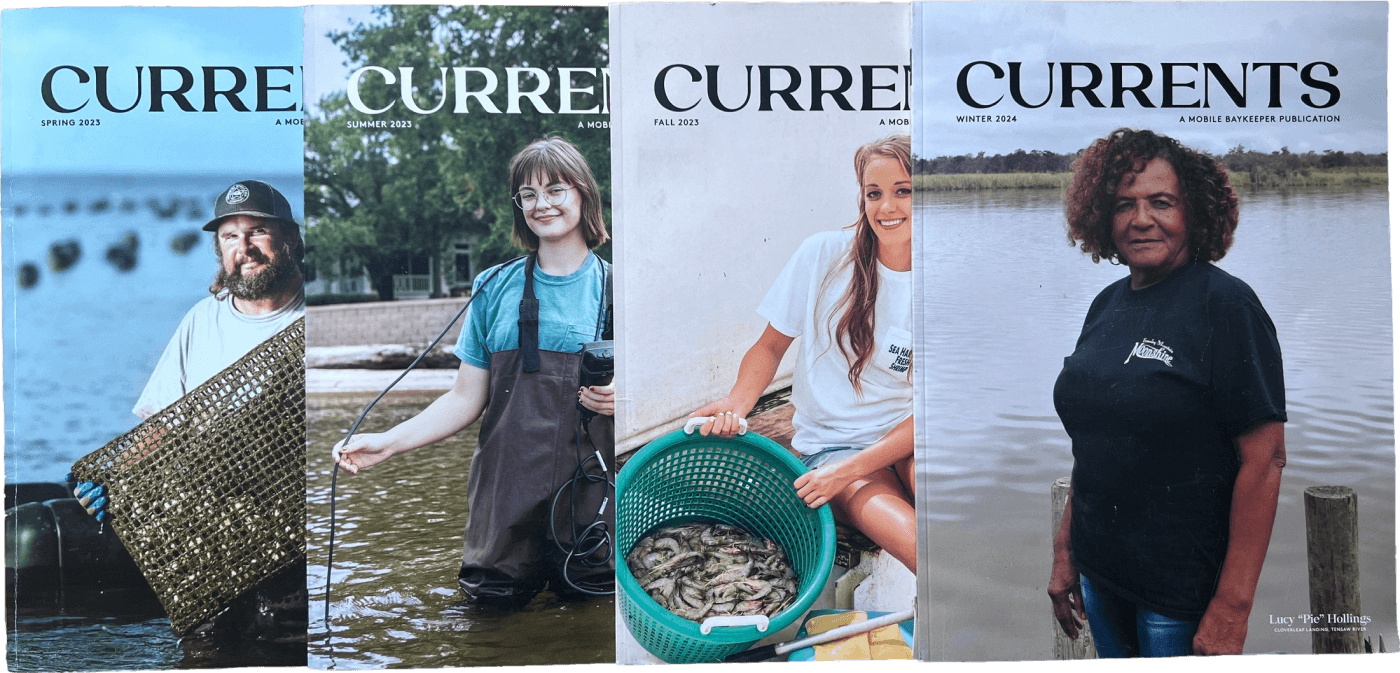
This article is from the summer 2025 edition of Mobile Baykeeper’s print quarterly, CURRENTS. The magazine is mailed to active members who have given more than $50 in the past year. To get on the magazine’s mailing list, donate here.
By Jodie Cain Smith
“Pick it up and carry it.” Those were Daddy’s orders to the four of us kids the day after Hurricane Elena stripped our pier pylons clean.
It was early September 1985. I was a skinny fifth-grader with arms like toothpicks. My siblings weren’t much stronger, but the four of us did as Daddy instructed and carried the ten-foot sections of our pier decking along the western shore of Mobile Bay back home. Lumber is expensive. When the storm broke our pier into neat ten-foot sections and deposited them along Dead Man’s Beach, my father looked at my mother, siblings, and me, knowing what had to be done.
For some, the moment a lower Alabamian becomes a bay rat is hard to pinpoint. Not me. That moment is forever imprinted onto my memory. Dragging, shoving, and complaining about those heavy sections of decking along the deserted stretch of beach is my moment. That was the day I claimed Mobile Bay as my own, the day the playground taunt of bay rat didn’t bother me anymore. Looking back, I know it was then that I began to understand three truths: every person that lives on the shores of Mobile Bay must have a relaxed grit; my father is clever; and being a bay rat comes with a price, with a side-tip of blisters and calluses.
The days leading up to Elena’s landfall on the Gulf Coast were filled with nervous excitement in my fifth-grade class at St. Dominic Elementary School, off Burma Road in Mobile. Although all of us were children of Hurricane Frederick, Elena was the first major storm in which we could be active participants. The nuns and lay teachers explained in plain terms what a storm of this size could do. We prayed the Angelus and extra rosaries so that the storm would fizzle out, and then the nuns handed out rolls of masking tape. I felt proud to do my part in protecting my school from the wind as we stretched swathes of tape from corner to corner of each window, even with a heavy helping of skepticism weighing on my mind. When we finished, sideways Xs covered every window along the rear walls of the classrooms.
The image of those Xs and the nervous, excited smiles on my friends’ faces often pop up in my mind’s eye. The excitement was due to guaranteed days off from school. We didn’t know where exactly Elena would come ashore, but we knew her landfall would be close enough to warrant at least a couple of days of freedom. That’s what my friends knew. But they were city kids. Looming hurricanes hit differently for bay rats. Over the next few days, I’d learn that lesson well.
When I returned home from school that day, I realized that hurricanes for bay rats — those of us whose front yards sat on Mobile Bay — were serious, anxious business. Inside my 1,200-square-foot childhood home, my mother dashed around, ordering the four of us kids to move anything of value to higher ground. She worried most over those things that couldn’t be replaced — her collection of hand-painted figurines, photo albums and reels of photo slides, her wedding China and crystal, and the Cain’s Kids dolls she stitched for each of her girls and so many girls across the Gulf Coast. She also worried over the pier. But we couldn’t move the pier to higher ground. Instead, Elena moved our pier with reckless disregard. Section by section, the rising water and pounding waves pried the sections loose of their pylons, then carried the sections north to Dead Man’s Beach — the stretch of land my siblings and I named so because of how mysterious and untouched it was.
Rules didn’t exist on Dead Man’s Beach, except rules of survival and unwritten, unsaid common-sense guidelines for staying out of trouble. Keep up with the oldest sibling on the trek or she will yell at me. Don’t venture into the thick woods that run alongside the beach unless I want to battle a bobcat, wild hog, or alligator, or race a water moccasin. (On all counts, I would end up in the loser category.) Watch for jagged shells, broken glass, and sharp debris unless I wanted a gash in my bare foot and to explain to my mother why I was so careless.
The lure of Dead Man’s Beach was the danger — unconquered nature versus four brave explorers. My siblings — two older sisters and one younger brother — and I never knew what we might find as we walked barefooted along the sand, leaping over driftwood logs and splashing through the shallows. Would we find a witch lurking in one of the little caves carved into the land, revealed only at low tide? Maybe another freshwater spring would burst through the orange clay, or an antique bottle would drift onto the beach. Whatever we found whenever we ventured onto Dead Man’s Beach, we knew in our bones that, as soon as we scaled the small bluff down from the grassy vacant lot to the soft sand waiting below, we were free. No adult law here, only nature and my siblings.
So, when my father had the audacity to force work upon us on the beach (no amount of whining affected him), I worked out of spite. My bay-rat heart knew that as long as my dad’s boards rested on Dead Man’s Beach, my little stretch of paradise was spoiled. That’s the day I began forming my own, bay-rat relaxed grit. And the ability to work hard to preserve my stretch of Mobile Bay. Clean it up. Curse the hurricane for dumping debris, and the careless boaters for littering in my bay. The work connected me to the land and water of Mobile Bay that day like never before, and the connection remains powerful.
Dead Man’s Beach no longer exists. The development boom of the 1990s and early 2000s tamed the large swaths of Mobile Bay’s western shore previously untouched by human hands. In Belle Fontaine, my siblings and I chose the name Dead Man’s Beach to capture the deserted essence of the mile-long stretch. The beach is now buried beneath a long rock bulkhead. I have no pictures of us adventuring back and forth along Dead Man’s Beach, which happened several times a week throughout my childhood. Camera phones didn’t exist, and no one worried with “If you don’t post it, it didn’t happen.” All that mattered then was that Dead Man’s Beach was real to us and unreal, our own private Terabithia.
Maybe the lack of evidence is why, decades past my childhood days on Dead Man’s Beach, while on a kayaking excursion with my dad, I decided I had to set a novel in this strange, beautiful place I don’t own but claim as mine. I had no idea then what the future held for me — that I’d soon have a baby boy, that my husband would retire from the Army, that I would give in to the siren call of Mobile Bay and move home. But I knew I had to write about the brackish water and enchanting landscape of Mobile Bay’s western shoreline. This bay rat owes Mobile Bay at least that.
Jodie Cain Smith is the author of Splintered Reeds and the founder of the Mobile Literary Festival. For more information, visit jodiecainsmith.com
